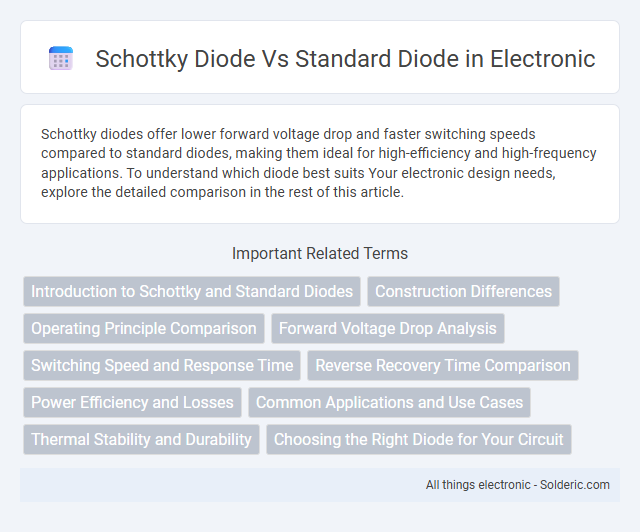Schottky diodes offer lower forward voltage drop and faster switching speeds compared to standard diodes, making them ideal for high-efficiency and high-frequency applications. To understand which diode best suits Your electronic design needs, explore the detailed comparison in the rest of this article.
Comparison Table
| Feature | Schottky Diode | Standard Diode |
|---|---|---|
| Forward Voltage Drop (Vf) | 0.15 - 0.45 V | 0.7 - 1.1 V |
| Switching Speed | Very High (nanoseconds) | Moderate (microseconds) |
| Reverse Recovery Time | Minimal | Significant |
| Reverse Leakage Current | Higher | Lower |
| Maximum Junction Temperature | Typically up to 125degC | Typically up to 150degC |
| Applications | High-speed switching, power rectification, RF circuits | General rectification, power control |
| Construction | Metal-semiconductor junction | PN junction |
| Cost | Higher | Lower |
Introduction to Schottky and Standard Diodes
Schottky diodes feature a metal-semiconductor junction providing low forward voltage drop and fast switching capabilities, making them ideal for high-frequency applications and power rectification. Standard diodes, typically fabricated with a p-n semiconductor junction, exhibit higher forward voltage drops and slower switching speeds, commonly used in general-purpose rectification and signal demodulation. The distinct junction types result in varied electrical characteristics influencing efficiency, thermal performance, and switching behavior across electronic circuits.
Construction Differences
Schottky diodes feature a metal-semiconductor junction, typically between a metal like platinum and an n-type semiconductor, resulting in low forward voltage drop and fast switching speed. Standard diodes use a p-n junction formed by joining p-type and n-type semiconductor materials, which leads to higher forward voltage and slower recovery times. Understanding these construction differences helps you select the appropriate diode for applications requiring efficiency and speed.
Operating Principle Comparison
Schottky diodes operate based on the metal-semiconductor junction, which allows for faster switching speeds and lower forward voltage drop compared to the standard diode's p-n junction structure. The reduced charge storage in Schottky diodes minimizes switching losses, enhancing efficiency in high-frequency applications. Your choice between these diodes depends on the required speed and power efficiency for your electronic circuit.
Forward Voltage Drop Analysis
Schottky diodes feature a significantly lower forward voltage drop, typically around 0.2 to 0.3 volts, compared to standard silicon diodes which generally have a forward voltage drop near 0.7 volts. This reduced voltage drop translates to higher efficiency and lower heat generation in your circuits, especially beneficial in power-sensitive applications. Evaluating forward voltage drop is crucial when selecting a diode to optimize energy consumption and thermal management.
Switching Speed and Response Time
Schottky diodes exhibit significantly faster switching speeds and lower response times compared to standard PN-junction diodes due to their metal-semiconductor junction, which reduces charge storage. This characteristic results in minimal reverse recovery time, making Schottky diodes ideal for high-frequency and fast-switching applications such as power rectifiers and RF circuits. In contrast, standard diodes experience longer switching delays because of their depletion region charge storage during reverse recovery, limiting their efficiency in rapid switching scenarios.
Reverse Recovery Time Comparison
Schottky diodes exhibit significantly faster reverse recovery times compared to standard PN-junction diodes, often in the range of nanoseconds versus microseconds, which reduces switching losses and improves efficiency in high-frequency applications. This rapid reverse recovery characteristic minimizes voltage spikes and electromagnetic interference, making Schottky diodes ideal for power rectification and fast switching circuits. Understanding this difference can help optimize Your electronic designs for better performance and energy savings.
Power Efficiency and Losses
Schottky diodes exhibit significantly lower forward voltage drop, typically around 0.2 to 0.3 volts, compared to 0.7 volts in standard silicon diodes, resulting in reduced conduction losses and improved power efficiency in high-frequency applications. The low forward voltage drop minimizes heat generation, enhancing thermal management and reliability in power circuits. However, Schottky diodes may have higher leakage currents, which can slightly impact overall efficiency under certain conditions.
Common Applications and Use Cases
Schottky diodes are commonly used in high-speed switching applications, power rectification, and voltage clamping due to their low forward voltage drop and fast recovery time. Standard diodes are preferred for general-purpose rectification and signal demodulation where higher voltage tolerances and slower switching speeds are acceptable. Your choice depends on the need for efficiency and switching performance versus robustness and cost-effectiveness.
Thermal Stability and Durability
Schottky diodes exhibit superior thermal stability due to their low forward voltage drop and minimal junction capacitance, which reduces heat generation during operation. Standard diodes often have higher thermal resistance, making them less durable under high-temperature or high-current conditions. Your choice of diode impacts the reliability of electronic circuits, with Schottky types offering enhanced durability in demanding thermal environments.
Choosing the Right Diode for Your Circuit
Schottky diodes offer lower forward voltage drops and faster switching speeds compared to standard diodes, making them ideal for high-efficiency and high-frequency applications. Standard diodes, such as silicon PN junction diodes, provide higher reverse voltage ratings and better thermal stability, suitable for general-purpose rectification and protection tasks. When choosing the right diode for your circuit, consider factors like voltage requirements, switching speed, and power efficiency to ensure optimal performance.
schottky diode vs standard diode Infographic

 solderic.com
solderic.com